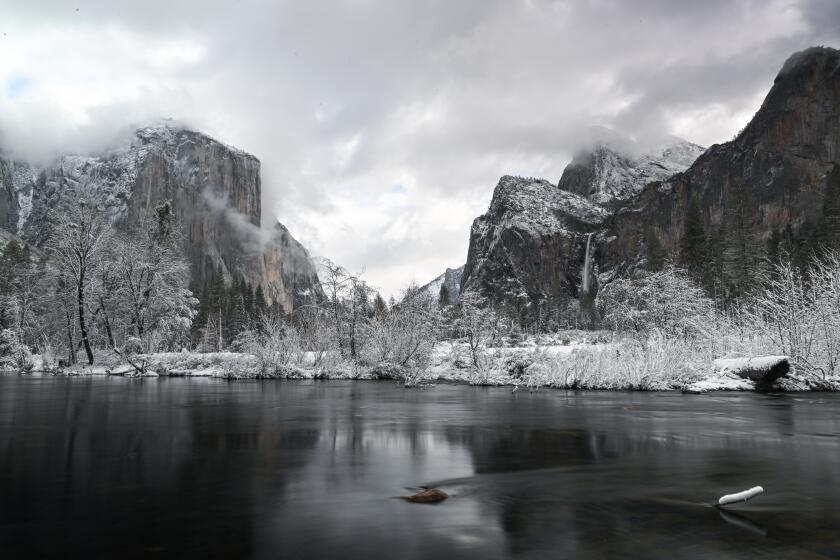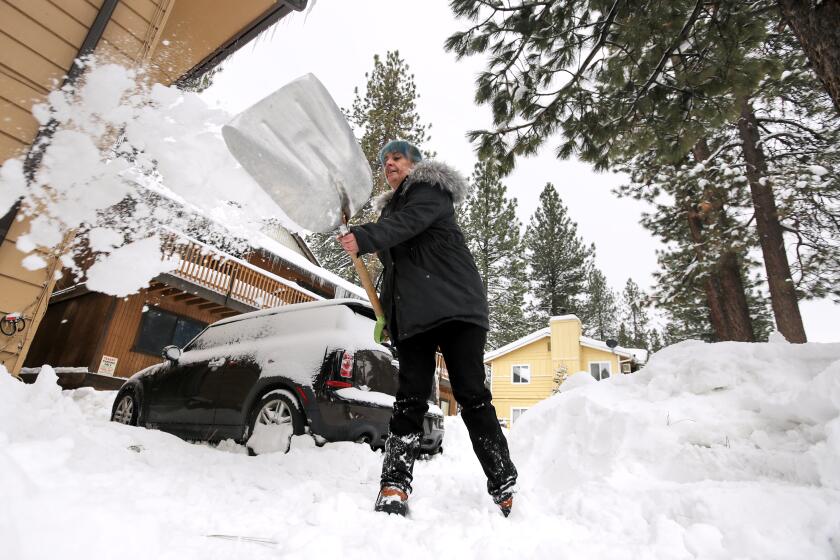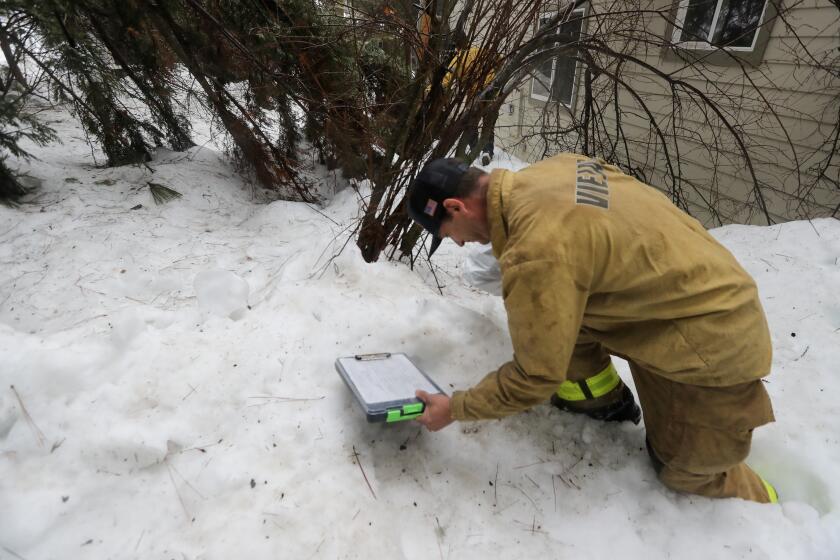Newsom declares state of emergency in 13 counties as winter storms hammer California

- Share via
California Gov. Gavin Newsom declared a state of emergency Wednesday evening for 13 counties, including Los Angeles, affected by winter storms that have ushered in unusual snowfall and strong winds and have damaged state highways and roads.
The other 12 counties under the order are: Amador, Kern, Madera, Mariposa, Mono, Nevada, San Bernardino, San Luis Obispo, Santa Barbara, Sierra, Sonoma and Tulare.
The order makes it easier to bring in resources from out of state and to hire snow-removal teams and equipment that isn’t always easy to access. It will also provide financial resources and reduce bureaucratic red tape that often stall disaster response at the local level, as well as activate the state National Guard and the California Department of Forestry and Fire Protection to support counties.
In Los Angeles County, the order might free up federal highway funds for road repairs, said Brian Ferguson, spokesperson for the California Governor’s Office of Emergency Services.
Meanwhile, dangerous weather conditions in the San Bernardino Mountains were forecast to ease up after heavy snowfall over the last several days blocked mountain roads and stranded residents. Ferguson said the declaration could bring relief in particular in San Bernardino County, especially in the hard-hit Lake Arrowhead and Big Bear Lake areas.
All roads inside the park have been restricted to administrative use only.
The Lake Arrowhead area saw a little more than 77 inches of snow over a seven-day period, according to meteorologist Samantha Connolly with the National Weather Service office in San Diego.
“That area could see a little more snow heading into next week,” she said, “but nothing as big as the drop that happened in the last storm that passed through.”
Road crews with Caltrans were forced to cancel their plans to escort residents up the San Bernardino Mountains on Wednesday morning. Heavy snowfall hampered drivers from making it up the mountain, even with chains on their tires, Caltrans said.
“We are working on clearing the roadway as quickly as possible to resume the escorts for residents for the next window,” the agency wrote on Facebook.
To help rescue people trapped in their homes, Ferguson said “the state is actually mobilizing National Guard and Cal Fire personnel to go door to door in those neighborhoods.”
“This is super unprecedented,” he said.
“I thank the governor for recognizing our communities that are in dire need of help,” said state Sen. Rosilicie Ochoa Bogh (R-Yucaipa). “The extreme snowfall has residents trapped in their homes, running out of food and medication.”
Crews race to clear mountain highways after calling off plans to escort residents out because even cars with chains on their tires were getting stuck in snow.
Wednesday’s storm was the last in a series and moved out of Southern California with a blast, bringing hail and graupel to many communities and plunging snow levels to 1,000 feet in some areas.
It was a day of rain, sunshine and then icy downpours, which spread from the South Bay and Long Beach to Disneyland and many valley and foothill communities.
The National Weather Service’s Los Angeles office reported a graupel shower in Malibu, about 540 feet above sea level.
There and in other parts of the L.A. area, the soft, snow-like crystal droplets floated down to the ground from otherwise sunny skies and were captured on social media by multiple people.
In Claremont, Shannon Burns was shocked to see a light dusting of snow falling outside her window.
“My general reaction was to completely disrupt a work call I was on so I could shout at people about it snowing,” Burns said.
By Wednesday afternoon, there were reports of snow at elevations as low as 1,000 feet, including in Claremont and Santa Clarita, according to the weather service.
The snow and icy conditions Wednesday morning led to the closure of Interstate 5 through the Grapevine, according to the California Department of Transportation. The department reported its reopening around 4 p.m., after the California Highway Patrol worked to clear stalled big rig trucks around the Tejon Pass and surrounding areas.
A large swath of the area around the Grapevine in Kern County was under a winter storm warning that was set to be in effect until 10 p.m. Wednesday, according to the weather service. The warning extended to the interior valleys of San Luis Obispo and Santa Barbara counties.
Cold wind, rain and snow will continue to pass over Southern California on Wednesday and gradually ease up by Thursday, according to forecasts.
California’s deadly storm season continued Friday as the first of two atmospheric river storms descended on the state, prompting evacuation orders.
“We should be dry for the next several days,” said meteorologist Mike Wofford with the National Weather Service office in Oxnard.
The weather service issued a wind advisory for Santa Clarita and the San Fernando and San Gabriel valleys until 4 a.m. Thursday. Winds could reach 20 to 30 mph, with gusts up to 50 mph, and will be “strongest in the foothills.” Los Angeles, Ventura and Santa Barbara mountains are also under a wind advisory until 4 a.m.
The California Highway Patrol reported a rockslide and boulders on Malibu Canyon Road, which closed the roadway in both directions from Civic Center Way to Piuma Road on Wednesday afternoon, according to Malibu Emergency Services. There was no estimated time for reopening.
Snowed under in the San Gabriel Mountains, Mt. Baldy Resort said on Twitter that there were “multiple life threatening avalanches” in the Movie Slope area and that Baldy Road was closed. The resort later announced it would be closed Thursday.
Other damage included downed trees throughout the region. The Los Angeles Department of Water and Power said its crews were responding to “multiple outages that have occurred as a result of strong winds from this afternoon” that had downed trees, power poles and wires.
Conditions will be dry in Los Angeles starting Thursday, with temperatures reaching into the low 60s for some areas. The temperature is still low for this time of season, Wofford said, but anyone setting foot outside will notice the difference after the long cold snap.
“It’s still going to be chilly out there,” Wofford said.
After a dry period from Thursday through Saturday for Los Angeles, Santa Barbara and Ventura counties, rain could return by the start of next week, according to forecasts.
More to Read
Sign up for Essential California
The most important California stories and recommendations in your inbox every morning.
You may occasionally receive promotional content from the Los Angeles Times.












